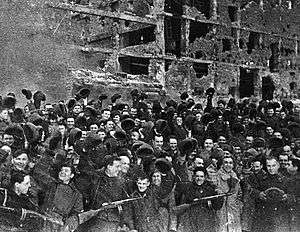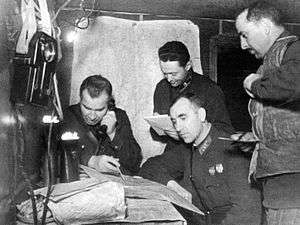95th Rifle Division
| 95th Rifle Division 1st Formation - November 1923 – 30 July 1942 2nd Formation - 2 Aug 1942 – 1 Mar 1943 3rd Formation - Order of the Red Banner, Order of Suvorov (2nd class), honorary name "Verkhnedneprovsk" 1 Mar 1943 - 1945 | |
|---|---|
| Active | Formed three times: November 1923, 2 Aug 1942, 1 Mar 1943 |
| Country | Soviet Union |
| Branch | Red Army |
| Type | Infantry |
| Size | more 12,000 (Second World War) |
| Engagements |
Winter War of 1939-1940 Defence of Sevastopol Battle of Stalingrad Operation Bagration |
| Battle honours | Order of the Red Banner, Order of Suvorov (2nd class), honorary name "Verkhnedneprovsk" (Third formation) |
| Commanders | |
| Notable commanders |
Colonel Alexander Grigoryevich Kapitokhin (First formation) |
The 95th Rifle Division (Russian: 95-я стрелковая дивизия 95-y strelkovaya diviziya ) was a Red Army Rifle Division during World War II, formed thrice. The division was first formed in November 1923 with the 6th Rifle Corps. It fought in the Winter War and the Soviet occupation of Bessarabia and Northern Bukovina. After Operation Barbarossa, the division fought in the retreat from Moldova and fought in the Siege of Odessa and the Siege of Sevastopol. It was destroyed during the Siege of Sevastopol and was disbanded in late July 1942. The division was reformed in August 1942 from the 13th Motor Rifle Division NKVD and fought at the Battle of Stalingrad. For its actions during the battle, the division became the 75th Guards Rifle Division in March 1943. In April 1943, the division was formed a third time at Kaluga from the 121st Rifle Brigade. It fought in Operation Bagration.
First Formation
The first time the 95th Rifle Division was formed in the 6th Rifle Corps of Ukrainian Military District during November 1923. It participated in the Winter War of 1939-1940 and in the Soviet occupation of Bessarabia and Northern Bukovina of 1940. With the beginning of the World War II it became part of the Separate Coastal Army, Defence of Odessa and Defence of Sevastopol. 95th Infantry Division (1st formation) was completely destroyed in the fighting and disbanded July 30, 1942.
Composition
The First Formation of 95th Rifle Division included the following units: [2]
- 90th Rifle Regiment
- 161st Rifle Regiment
- 241st Rifle Regiment
- 57th Artillery Regiment
- 134th Howitzer Artillery Regiment
- 97th Separate Antitank Battalion
- 194th Anti-aircraft Battery (175th Separate Anti-aircraft Artillery Battalion)
- 13th Reconnaissance Company
- 48th Separate Sapper Battalion
- 91st Separate Communications Battalion
- 103rd Medical Battalion
- 30th Separate Chemical Defence Company
- 46th (283rd) Trucking Company
- 174th (47th) Field Bakery
- 7th Divisional Veterinary Hospital
- 321st Mobile Car Repair Workshop
- 126th Divisional Artillery Repair Workshop
- 163rd Field Post Office
- 348th Field Ticket Office of the State Bank
Division Commanders
- Major General Pastrevich A.I. (17.01.1941 — 15.07.1941)
- Major General Vorobyov V.F. (10.08.1941 — 29.12.1941)
- Colonel Kapitohin A.G. (01.01.1942 — 17.07.1942)
Second Formation
95th Rifle Division (2nd formation) was established on the basis of the 13th Motor Rifle Division NKVD, which by the order of the NKVD № 001 547 from 07.28.1942 was transferred to the Red Army and in accordance with the directive of the General Staff of the Red Army (org / 2/2172 from 02.08.1942) was reformed in the 95th Rifle Division .[3] The 4th Motorized Rifle Regiment of the NKVD became the 90th Rifle Regiment, 266th Rifle Regiment – 161st Rifle Regiment, 274th Rifle Regiment – 241st Rifle Regiment.
September 2, 1942 the Division in the amount of 12 800 men and officers were directed to the Western Front and arrived at the station Mozhaysk but then received another order to follow in the disposal of the 62nd Army in Stalingrad. In the evening on September 17 trains come to the stations Leninsk and Zaplavnoe (Medial Akhtuba). Having made a 40-km march, the Division came at the left bank of the Volga in front of Stalingrad, to the ferriage of the 62nd Army. The night of September 18 into Stalingrad crossed over the 90th and 161st Rifle Regiment, 97th separate antitank battalion, 96th engineer battalion and division headquarters. The Division received an order to beat out the enemy from a height 102.0 (Mamayev Kurgan) by using the available forces and they engaged in the battle, captured top of the Hill, but could not advance further due to the big losses under heavy artillery and mortar fire. The rest of the Division crossed the Volga late because the crossing was subjected to constant blows of the enemy and was only possible at night. During September 19–27 the Division continued to bloody battles against superior enemy forces, supported by tanks and aircraft, but in spite of heavy losses, held the Mamayev Kurgan. Division headquarters was located in the ravine Banny at the foot of Mamayev Kurgan. 28 September due to the deterioration of the situation near factory "Red October", the Division was ordered to give the defense of Mamayev Kurgan to 284th Rifle Division of Colonel Batiouk N.F. and defend the factory "Red October" and working settlement.
In October, together with the 37th Guards Rifle Division of Major-General Zholudev V.G., the Division defends Tractor Plant. October 14 the Germans launched a powerful offensive, leaving the battle all that they possessed, but the Division maintained its position, bearing thus huge losses - 15 October losses amounted to about 75 percent of combat composition. 17 October the Division remains were consolidated into one - 161th Rifle Regiment. Division headquarters and the headquarters of the two other Regiments were sent to the left bank of the Volga for replenishment.
In early November, the Division again kept the defense under the steep bank of the Volga, being pressed to the water. Neighbors on the right flank were the 138th Rifle Division of Colonel Lyudnikov I.I. and the 308th Rifle Division of Colonel Gurtiev L.N., and on the left - the 45th Rifle Division Colonel Sokolov V.P. and the 39th Guards Rifle Division, General-Major Guriev S.S.
November 11 the enemy launched a massive attack of the Division position by two infantry divisions, which were supported by tanks. The defense of the 241th Rifle Regiment, was broken, and German troops reached the banks of the Volga in the width of 500 meters. The 62nd Army was divided at the junction of 95th and 138th Rifle Divisions. Further enemy advance was halted, but at the cost of heavy losses. November 19 began the counteroffensive of the Soviet troops (Operation Uranus), and the enemy was forced to reduce the activity of fighting in Stalingrad. When November 23 the insulation 6th Army of Paulus was completed, the Germans had to go on the defensive. The division continued to battle, destroying enemy garrisons, which had a very strong resistance. December 23 the Division broke through the enemy positions and has established direct contact with the 138th Rifle Division of Colonel Lyudnikov.
From December 29, the division was fighting for the Plant "Barricades". The morning of February 2, after a short artillery bombardment, the enemy was attacked in the area Tractor Plant and "Barricades" Plant and the 95th Rifle Division, together with units of the 45th Rifle Division captured the Plant "Barricades". The northern group of enemy troops in the factory district of the city capitulated and the battle of Stalingrad finished.
According to the Journal of hostilities as of February 1, 1943 in the 95th Rifle Division the number of soldiers were: 90 regiment – 20 men, 161 regiment – 85 men (including 22 fighters of mortar units), 241 regiment – 49 (including 22 fighters of mortar units).[4] Veterans remembered that during the fighting in Stalingrad through the Division have passed about 60 000 people, but in an echelon, which was transporting the Division to re-forming, there were about 600 people. For excellent military operations to defeat the Nazi troops 398 men and officers of the 95th Rifle Division were awarded orders and medals.
March 1, 1943 by the Order of the People's Commissariat of Defense of the USSR number 104 the 95th Rifley Division was reorganized into the 75th Guards Rifle Division.

|
|
Composition
The Second Formation of 95th Rifle Division included the following units: [5]
- 90th Rifle Regiment
- 161st Rifle Regiment
- 241st Rifle Regiment
- 57th Artillery Regiment
- 97th Separate Antitank Battalion
- 13th Reconnaissance Company
- 48th Separate Sapper Battalion
- 119th Separate Communications Company
- 103rd Medical Battalion
- 30th Separate Chemical Defence Company
- 283rd Trucking Company
- 174th Field Bakery
- 7th Divisional Veterinary Hospital
- 1766th (2054th) Field Post Office
- 1723rd (652nd) Field Ticket Office of the State Bank

Commanders
- The Division commander, Colonel Gorishnii V.A.
- The military commissar of Division, Colonel Vlasenko I.A.
- Head of Division artillery, Lieutenant Colonell Dalakishvili A.A.
- The commander of the 90th Rifle Regiment, Lieutenant Colonel Borisov M.S.
- The commander of the 161th Rifle Regiment, Lieutenant Colonel Rudnev I.V. (KIA September 19, 1942 on Mamayev Kurgan); Major Makovetskii F.E.
- The commander of the 241th Rifle Regiment, Major Selimov.
- The commander of the 57th Artillery Regiment, Lieutenant Colonel Levkin N.A.
Third Formation
95th Rifle Division (3rd formation) was created in Kaluga 15 April 1943 by the order of Headquarters of the command of the Supreme Commander № 46081 from 20.03.1943. Towards the end of the World War II, the Division was awarded the Order of the Red Banner, the Order of Suvorov (2nd class) and the honorary name of "Verkhnedneprovsk".[6]
Composition
The Third Formation of 95th Rifle Division included the following units: [7]
- 90th Rifle Regiment
- 161st Rifle Regiment
- 241st Rifle Regiment
- 57th Artillery Regiment
- 97th Separate Antitank Battalion
- 13rd Reconnaissance Company
- 48th Separate Sapper Battalion
- 119th Separate Communications Company
- 103rd Medical Battalion
- 30th Separate Chemical Defence Company
- 283rd Trucking Company
- 174th Field Bakery
- 7th Divisional Veterinary Hospital
- 1766th Field Post Office
- 1723rd Field Ticket Office of the State Bank
References
- ↑
- ↑ "Действующая армия. Перечни войск. Перечень № 5. Стрелковые, горно-стрелковые, мотострелковые и моторизованные дивизии" [95th Rifle Division (1st formation)].
- ↑ "Рабоче-крестьянская Красная Армия, 1948-1945" [75th Guards Rifle Division].
- ↑ Journal of hostilities of the 95th Rifle Division
- ↑ "Действующая армия. Перечни войск. Перечень № 5. Стрелковые, горно-стрелковые, мотострелковые и моторизованные дивизии" [95th Rifle Division (2nd formation)].
- ↑ "Рабоче-крестьянская Красная Армия, 1948-1945" [95th Rifle Division (3rd formation)].
- ↑ "Действующая армия. Перечни войск. Перечень № 5. Стрелковые, горно-стрелковые, мотострелковые и моторизованные дивизии" [95th Rifle Division (3rd formation)].